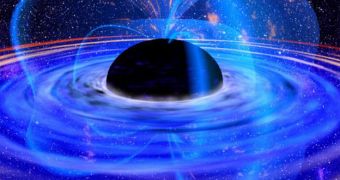Astrophysicists have known for a long time that the black hole dubbed V404 Cygni is one of the closest to our planet ever discovered. Still, they were unprepared when new measurements of the distance that separated us from it revealed that the object was, in fact, nearly two times closer than first predicted. Using modern measurement techniques, the team that was in charge of the new study was able to determine that V404 lay some 7,800 light-years away, Space reports.
For those of you who think that the distance is very large, consider that we are some 26,000 light-years away from the galactic core of the Milky Way, and the supermassive black hole it contains. Experts say that the new measurements will provide them with a new means of conducting black hole research, in that they will be able to find new ways of explaining how the mysterious structures grow during their life times.
“For example, we hope to be able to answer the question as to whether there is a difference between black holes that evolve directly from the collapse of a star without a supernova and black holes that evolve via a supernova and a temporary intermediate star. We expect that the black holes in the last group can get a kick. Black holes formed in this way could then move through space faster,” SRON Netherlands Institute for Space Research expert Peter Jonker, a member of the new study team, says.
The expert group was able to make the new measurements by determining the direct radio emissions coming from the black hole, as well as from one of the dying stars around it. This star is currently having its outer atmospheric layers removed by the black hole, and siphoned into the behemoth's accretion disk, from where they will eventually fall through the event horizon. The process is highly active, as the disk is heated to infernal temperatures, producing massive amounts of X-rays and radio waves, the team says.
In the new paper, which appears in the December 1 issue of the respected Astrophysical Journal, the team also reveals that it used the High Sensitivity Array international radio telescope system for the new investigations. The group also says that the previous measurements were contaminated because the methods used had a margin for error of about 50 percent, whereas the new technique has a six-percent chance of inaccuracy.

 14 DAY TRIAL //
14 DAY TRIAL //